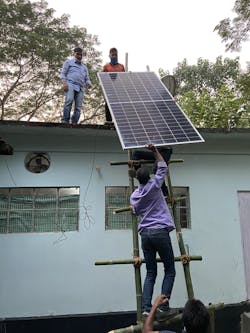In remote villages in the Himalayas, medical centers often lack critical medical equipment, refrigerators for vaccines and dependable electricity for light and other essentials. But Paras Loomba intends to change that, bringing solar microgrids to medical centers, which will allow for vaccine storage, baby warmers, ventilators and other items that will help attract tourists and serve villagers.
His company, Global Himalayan Expedition (GHE), recently completed solar microgrids that serve medical centers in two remote areas — one in Sato, a village in the Changthang area of Ladakh that’s 31 miles from a larger, better equipped primary health care facility.
The other microgrid was installed at the Purakhasia Primary Healthcare Center in the jungles of northeast India — one of the wettest regions of the world — where about 50% of patients were dying due in part to a lack of a reliable power supply needed for medical equipment, he said.
Staff grappled with the challenges of the center being served only two to three hours a day with electricity. Power failures and lack of electricity discouraged people from coming to the center for help.
Traveling to these areas is difficult because roads are primitive, temperatures are cold and few supplies — such as wood — are available for building, said Loomba, founder of GHE. That’s where “frugal innovation” comes in.
Innovation and care
In the Purakhasia Primary Health Center project, no ladders were available, so a building team fashioned them out of bamboo.
“You don’t have ladders in these areas, in the jungle. That’s where frugal innovation comes in, whatever is available makes it happen,” said Loomba.
Because the solar panels, from REC Solar — are heavy but fragile, the locals treat them like “babies,” padding them in trucks with mattresses and any other materials on hand to get them to their destination without breaking them, he said. And the valuable panels are only transported through the jungle during the day, because at night travelers can become the targets of terrorists, he said.
Villages in the Himalayas are served by two types of medical centers: primary healthcare centers such as the one in Purakhasia, which serves about 40,000 patients a year, and medical “subcenters” such as the one in Sato, which are located in every village. The subcenters are generally staffed by a single nurse.
In spite of the challenges, GHE installs the microgrids in about a month.
In both the primary facility and the subcenter, GHE installed microgrids consisting of 7 kW of solar and 16 kWh of storage that allow 24/7 operations. The peak load in these facilities is generally about 2.5 kW. Oversizing the systems allows them to run for up to two days in cloudy weather, said Loomba. His company, working with original equipment manufacturers, makes the lead acid batteries, which are needed to survive cold weather, as low as 20 degrees below zero.
The company can equip each facility with the 9 kW microgrid and critical medical instruments for about $20,000 to $25,000 (US) for a 7 kW setup plus critical medical instruments, he said.
Funding the solar microgrids
Not only is innovation involved in installing and commissioning the solar microgrids, but it’s also at the heart of funding the projects. GHE runs tours of the region, and asks the participants if they’d like to provide funds above the cost of the tour to help pay for electrification efforts.
“When we offer an expedition, for anyone wanting to come from the US, Europe or other places, the tourists get excited about coming here, We tell them the cost of the expedition, around $1,200 for 12 days, and if they pay $600 more, they can help electrify a village. That excites the tourists and they fundraise to pay for it,” said Loomba.
GHE also uses corporate sustainability grants — provided by companies with sustainability goals — to fund the microgrids in healthcare facilities.
The Global Himalayan Expedition last year won the top prize in the Microgrid Knowledge Greater Good Award contest. Join us at Microgrid 2021 for the announcement of this year’s winners. Registration is free to attend the virtual conference, but limited to 5,000 registrants.
Local entrepreneurism
Once the solar microgrid is up and running, GHE operates it for two or so years. The company trains a local person, generally a youth, to operate the system, handing over operations to the community.
“The entrepreneur supports the project, and we provide backup. We mobilize the community, get the electrical part of the microgrid technology intact, then we leave and there’s a sustainable model,” he said.
While GHE’s non-medical projects are owned by the community, the microgrids in medical facilities will be owned by the Indian government, said Loomba.
An important byproduct of the project is increased confidence in medical facilities, which will help draw more tourists and boost incomes for local people. In the Himalayas, people offer food and lodging to tourists, often in their homes, which helps them earn a living.
When adequate medical care isn’t available, the tourists are less likely to stay overnight in such remote areas.
Uptick in patients
Now that the two medical centers are electrified 24/7, they have begun experiencing an uptick in patients. In Sato, the number of patients has increased by 30%, and at the second facility, patient numbers increased by 40% or more, said Loomba.
Patient numbers are expected to increase dramatically once the village of Sato — a tourist destination — opens up to travel. Right now, no traveling is allowed there due to the COVID-19 epidemic. Loomba expects patient numbers to jump from about 100 per week to 300 or 400 per week. It’s common for tourists to visit medical centers for oxygen-related issues due to the region’s high altitude.
Yet another benefit of the company’s electrification efforts is the reduction of diesel use. The Sato project had some solar, but the Purakhasia Primary Healthcare Center used some diesel, which created noise and air pollution. The center wants to use the diesel cost savings to purchase medical devices.
Continuing to electrify the Himalayas
From here, Loomba is working to add microgrids to 200 medical facilities. Ten medical centers will support 40 to 50 villages.
In spite of the rugged conditions and primitive roads, Loomba is pursuing an ambitious goal.
“We are looking forward to doing at least 50 medical centers in the next 12 months,” he said. “If expeditions launch, and travel comes back, we will do expeditions. We will use the tourism and corporate social responsibility models to fund them.”
Loomba is happy that these projects have improved healthcare, reduced diesel emissions, provided work for local people and allowed for increased vaccine capacity during the COVID-19 pandemic. And he’s excited that more people are now going to the medical centers for help.
“The public has taken notice,” he said.
Clearly, his frugal innovation is paying off.








